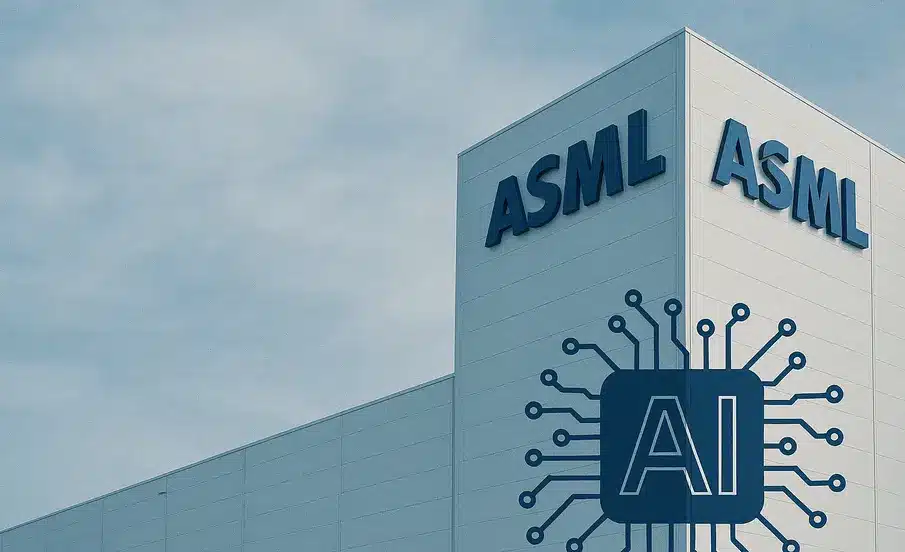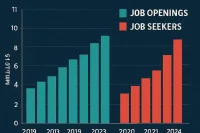ASML orders beat expectations — Q3 earnings analysis
ASML orders beat expectations in Q3 2024, with order bookings reaching €5.4 billion—above consensus estimates and nearly matching net system revenue of €5.5 billion. The Dutch semiconductor equipment maker reported revenue of €5.7 billion, slightly below the midpoint of guidance but largely in line with expectations. With a €33 billion backlog maintained from Q2, ASML appears well-positioned to meet 2025 revenue targets despite mixed signals from major customers.
Table of Contents
Q3 financial performance breakdown
Revenue and guidance
ASML’s Q3 revenue of €5.7 billion fell slightly below the midpoint of guidance but remained within expected ranges. The company’s full-year 2024 revenue projection of approximately €32 billion aligns with consensus expectations, indicating steady execution despite market headwinds.
Order bookings strength
The €5.4 billion in order bookings exceeded analyst expectations, demonstrating continued demand for ASML’s advanced lithography systems. This figure closely matched net system revenue, suggesting balanced order-to-revenue conversion.
Backlog and 2025 outlook
Stable backlog position
ASML’s order backlog remained stable at approximately €33 billion at the end of Q3, similar to Q2 levels. This substantial backlog provides visibility into 2025 revenue, with consensus estimates projecting around €33.2 billion in revenue—a 4% year-over-year growth rate.
Management confidence
ASML management has indicated that 2026 revenue will not fall below 2025 levels, providing reassurance about medium-term growth prospects despite potential customer CapEx adjustments.
Customer CapEx dynamics
Intel’s CapEx reduction
Intel’s planned CapEx cuts for 2025 reflect current market conditions and competitive pressures. While this may impact near-term equipment orders, ASML’s diversified customer base helps mitigate concentration risk.
TSMC’s measured approach
Taiwan Semiconductor Manufacturing Company (TSMC), ASML’s largest customer, is expected to maintain significant but less aggressive spending in early 2025. This measured approach aligns with broader industry caution around capacity expansion.
AI investment boom implications
Long-term demand drivers
The AI investment boom continues to drive demand for advanced semiconductor manufacturing equipment. ASML’s extreme ultraviolet (EUV) lithography systems are essential for producing the most advanced chips used in AI applications.
Technology leadership
ASML’s position as the sole supplier of EUV lithography systems provides significant competitive advantages in the AI-driven semiconductor market, where cutting-edge manufacturing capabilities are increasingly critical.
Market outlook and challenges
Near-term headwinds
While ASML’s order book remains strong, the company faces near-term challenges from customer CapEx adjustments and broader semiconductor market uncertainty. The lack of aggressive spending announcements from major customers suggests a more cautious industry approach.
Long-term growth drivers
Despite short-term challenges, the fundamental drivers of semiconductor demand—including AI, 5G, and automotive applications—support long-term growth prospects for ASML’s advanced lithography systems.
Hire Talent for the Future of Semiconductors
Even as near-term headwinds challenge the industry, long-term growth in AI, 5G, and automotive tech is driving demand for advanced semiconductor innovation. Employers can seize this moment by hiring top talent ready to navigate uncertainty and build the technologies of tomorrow. Post your job on WhatJobs today and connect with semiconductor professionals who can power long-term growth.
Post a Job Free for 30 Days →Investment implications
Revenue visibility
ASML’s substantial backlog provides strong revenue visibility for 2025, with the €33 billion backlog likely sufficient to cover next year’s projected revenue of approximately €33.2 billion.
Technology moat
The company’s technological leadership in EUV lithography creates significant barriers to entry and pricing power, particularly as chip complexity continues to increase with AI applications.
FAQs
Q: Why did ASML orders beat expectations in Q3 2024?
A: Strong demand for advanced lithography systems driven by AI investment boom, with €5.4B in order bookings exceeding consensus estimates.
Q: What does the backlog tell us about ASML orders beat expectations?
A: The €33B backlog provides strong revenue visibility for 2025, with orders nearly matching revenue and supporting 4% growth projections.
Q: How do customer CapEx changes affect ASML orders beat expectations?
A: Intel’s CapEx cuts and TSMC’s measured spending may impact near-term orders, but ASML’s diversified customer base and technology leadership provide resilience.
Q: What’s the outlook for ASML orders beat expectations in 2026?
A: Management expects 2026 revenue to not fall below 2025 levels, supported by AI-driven demand for advanced semiconductor manufacturing equipment.
Live example — user point of view
As a semiconductor investor, I’ve been tracking ASML’s order book as a leading indicator of chip demand. The Q3 beat on orders, combined with stable backlog, suggests the AI investment cycle is still driving equipment demand despite broader market caution. This reinforces my thesis that advanced lithography remains a bottleneck in the AI supply chain.




